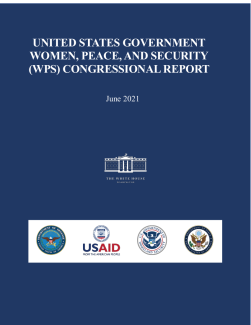The United States is a steadfast supporter of the Women, Peace, and Security (WPS) agenda. Long before the passage of UN Security Council Resolution (UNSCR) 1325 in 2000 and the enactment and implementation of the first comprehensive law on WPS in 2017, the United States government (USG) has been implementing the WPS agenda through diplomacy, development, defense, and international cooperation, through its specific missions and its relevant Departments and Agencies.
The WPS Act of 2017 (P.L. 115-68) (WPS Act) required the President to submit to Congress the U.S. Strategy on Women, Peace, and Security (WPS Strategy), which launched in 2019. The Strategy called for the Departments of Defense (DoD), Homeland Security (DHS), and State, as well as the U.S. Agency for International Development (USAID), to submit agency-specific Implementation Plans to measure and report on progress. The following public report to Congress evaluates the USG’s progress in advancing the WPS Strategy’s four Lines of Effort (LOEs): 1) Participation; 2) Protection; 3) Internal Capabilities; and 4) Partnerships. As each of the four departments and agencies have unique and tailored missions, the data and timeframes presented in their reports differ.
The reports highlight accomplishments, gaps, opportunities, and next steps that Departments and Agencies identified through various data collection and analysis processes and highlight lessons learned to inform future efforts. A summary of each department’s and agency’s reports are as follows:
Department of State
Drawing from a new metrics framework in the Department of State Plan to Implement the WPS Strategy (Implementation Plan), this report marks the first time that State has led a data-driven monitoring, evaluation, and learning exercise on its WPS efforts. It establishes a strong baseline against which future State progress will be evaluated, marking the start of an iterative process for the Department to improve evidence based WPS implementation and decision-making. From FY 2019 to FY 2020, State supported at least 14,013 women to build support for peace and reconciliation, trained more than 43,000 women in the security and criminal justice sectors, and supported access to gender-based violence (GBV) prevention and response services for as many as 487,922 individuals. State invested approximately $138 million in FY 2018 and FY 2019 in assistance programming to advance WPS and more than quadrupled the number of strategies, policies, and programs informed by a gender analysis. In addition, State undertook robust efforts in its internal capacity to lead on WPS through training, analysis, and coordination.
U.S. Agency for International Development (USAID)
In accordance with the commitments of USAID’s WPS Implementation Plan, USAID increased its efforts to consult with local women leaders, civil society, including faith-based organizations, as well as academia in countries affected by crisis and conflict. From FY 2018 to FY 2020, USAID supported the participation of over 184,000 women in leadership, conflict mediation, legal, political, and peacebuilding processes and provided critical-health care, psychosocial support, legal aid, and economic services to more than 13.5 million survivors of GBV. From FY 2018-FY 2020 funds, USAID invested over $400 million in programming designed to empower and protect women and girls in countries affected by crisis, conflict, violent extremism, and natural disasters.
Department of Homeland Security
For DHS, this report is the first report on WPS and serves to benchmark current progress starting from 2020. After the DHS Implementation Plan was approved in May 2020, DHS established internal communication structures and focused on gathering baseline data for the first USG WPS interagency report. In FY 2020, U.S. Customs and Border Protection (CBP) staff trained 110 female foreign nationals through the International Law Enforcement Academy (ILEA). U.S. Citizenship and Immigration Services (USCIS) staff provided Brazilian women counterparts with country of origin and travel documentation training in addition to a protection officer interview training to an additional 63 female foreign nationals. Through its mentoring programs (including the DHS-wide Women In Law Enforcement Mentoring Program), emergency response training, law enforcement trainings, and leadership programs, the Federal Emergency Management Agency (FEMA), Immigration and Customs Enforcement (ICE), Transportation Security Administration (TSA), and CBP collectively trained 284 women in DHS programs that components identified as integrating WPS principles. Further, as the largest Federal law enforcement agency, DHS trained 12,648 women to enter the law enforcement ranks at Federal Law Enforcement Training Centers (FLETC) in FY 2019 and FY 2020.
Department of Defense
The Department of Defense WPS Strategic Framework and Implementation Plan (SFIP) established three Defense Objectives to support the WPS Strategy’s LOEs: (1) modeling and employing women’s meaningful participation: (2) promoting partner nations’ women’s participation; and (3) ensuring partner nations protect women and girls, especially during conflict and crisis. In the early stages of SFIP implementation, DoD focused on building its WPS capability to mainstream WPS principles across all DoD components. In FY 2020, DoD programmed $7 million to place and train WPS experts in key positions and undertake activities to build partner capacity to advance WPS principles. In addition to staffing, training plays a large part in building DoD’s capability to implement WPS. In FY 2020, DoD overhauled existing WPS training and developed additional training to meet the growing need and demand for WPS instruction

